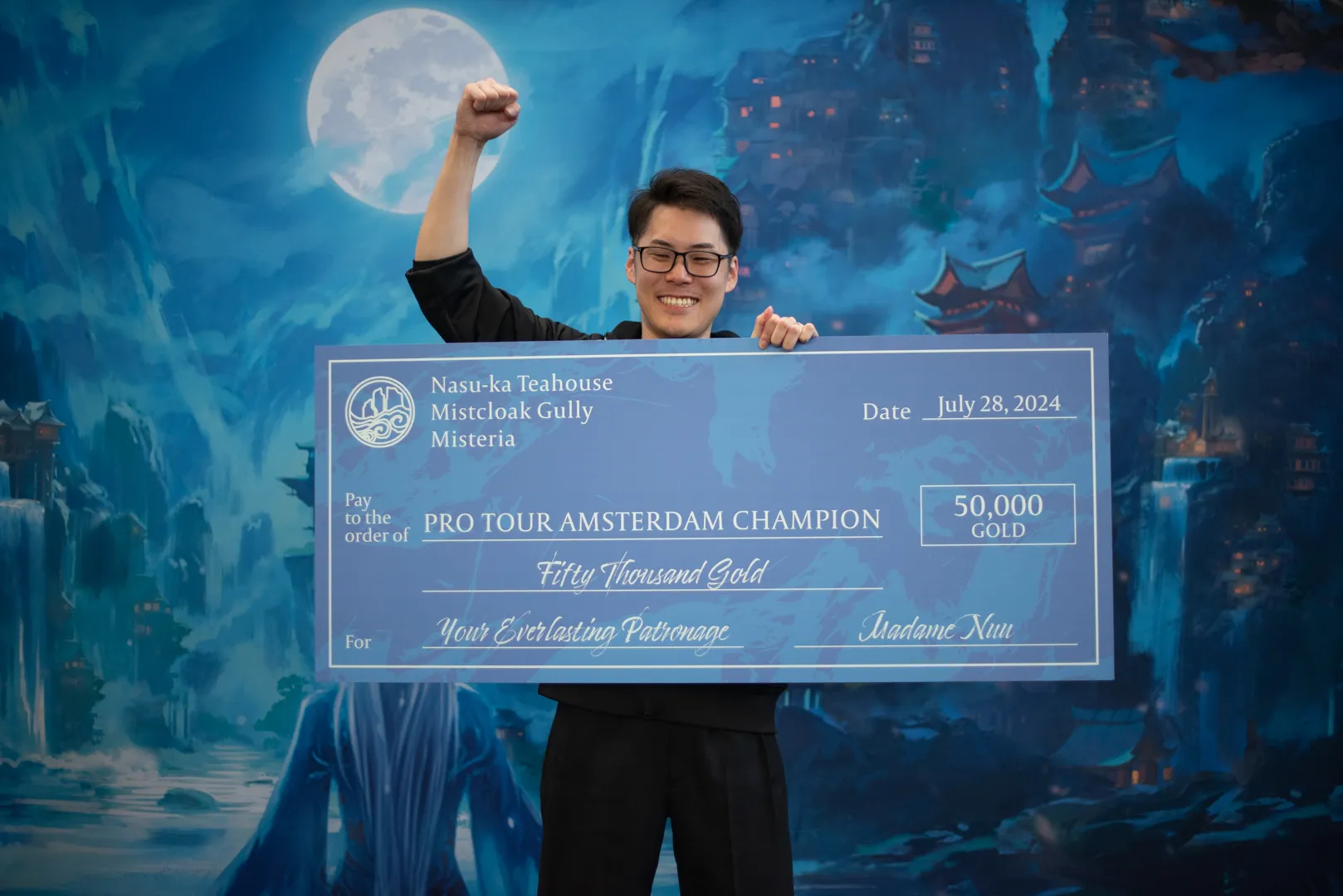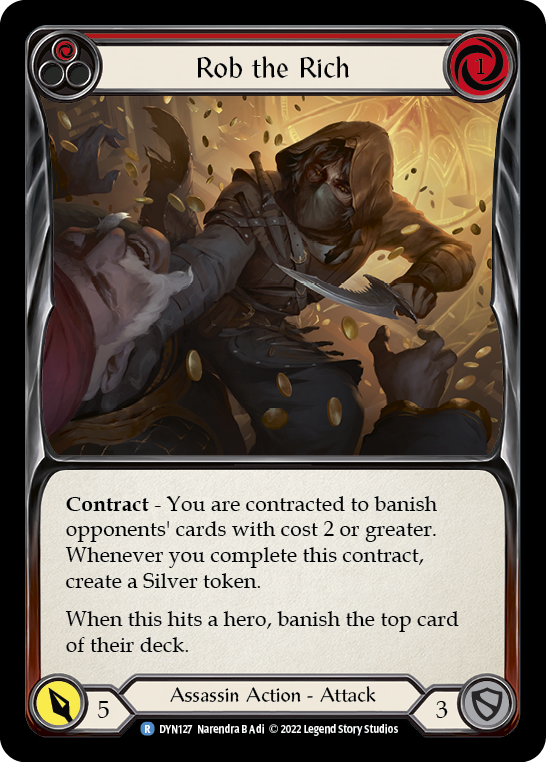This past weekend, an underdog story of Olympic proportions was playing out not in Paris, but in Amsterdam. Shoma Yamamura, a relative newcomer to the competitive FAB scene and one of only 2 players to register Uzuri for the Pro Tour, was in the Top 8 alongside 3 Zens, 3 Nuus, and a rogue Levia. The journey to this point had been well documented, first as a curiosity and then as an exciting competitive prospect. In a series of streamed games, the wide FAB community was presented with indisputable evidence that not only was Uzuri a real deck, but it was actually advantaged against the top decks of the Mistveil meta. And somehow, we'd all missed it.

Shoma Yamamura of Japan, Pro Tour Champion.
In interviews throughout the weekend, Shoma identified himself as an Uzuri main, joining a long tradition of specialists getting better-than-predicted results with their off-meta heroes. We saw another example of this in Kevin Zänker's Top 8 Levia - but there we also confront the hard truth that most underdogs don't win. Watching Kevin play Levia, we saw the precariousness of her position; Levia was often a breath away from disaster, and it truly felt like Kevin was fighting for those wins.
Not so with Shoma. In most of those games, Uzuri didn't look like an underdog at all. She felt favored against the toughest opponents in the format, confidently in control of the games. For a moment in the quarter-finals, it seemed like we might see karma catch up with Shoma - but once he found the win there, he stayed in the driver's seat straight through to the title.
It felt nothing like the underdog arc we're used to seeing. Shoma wasn't simply relying on the refined skills of a specialist piloting their favorite deck. It felt like we'd missed it. We'd simply slept on Uzuri.
The Assassin Complex
After fleshing out the initial roster of 8 classes, LSS has been slow to add more, preferring to use heroes and talents to diversify the card pool. But over time, they have added classes; and the most recent of those is Assassin. Debuting in the supplemental set Dynasty, our first taste of Assassin gameplay was rather gimmicky, and it's flavored our impression of the class ever since. Arakni's chief strategy was active fatigue, focusing on banishing cards with a hyper-fixated card pool built around the effect. Conceptually, a banished card is worth 3 points - but only if, later in the game, they go to draw and it isn't there; until then, Assassin attacks are simply reducing hypothetical options, their on-hit effects creating no immediate advantage.


Arakni has since been deemed largely irrelevant by Assassin players, and it's hard to make the case otherwise. Other Assassins can also banish cards; Arakni only adds the opportunity to banish slightly more relevant cards, improving his odds at fulfilling a contract for a reward of Silver - used either to cycle cards or buy back spent equipment. But if we determine that banished cards only have concrete impact once the absence of that card is felt; and if we consider that the only buyback equipment commonly used is Blacktek Whisperers; and if we also factor in the things Arakni can't do that other Assassins can... well, it's understandable to declare Arakni a relic in the face of his predecessors. Only his recent specialization, Coercive Tendency, offers something desirable that no other Assassin can do - unless, of course, you want to slay a Royal.


Into this climate walks Uzuri, the heir apparent to the Assassin class. Largely abandoning the goal of banishing cards, Uzuri instead focuses on the stealth tag - a hollow keyword that relies on its hero to define it. For Uzuri, stealth means, "This attack might become something else", a seemingly vague threat that, in practice, usually means, "This is a 6-power generic with an on-hit." Traditionally, Uzuri has presented a gameplay pattern akin to Dorinthea: a bluffing game that, at its best, forces opponents to block incorrectly. The impact of such a strategy varies greatly by the meta; its success depends on how comfortable decks are with blocking, and how capable they are at improvising.


Outsiders had the unfortunate position of releasing into the Uprising meta, and so Uzuri debuted in a meta that still contained Dromai and Iyslander; by comparison, the heroes of the Pits were incredibly tame. But Ninja had Fai and Katsu to prop it up; Ranger had Lexi and, later, Azalea to amplify the class' prestige. Uzuri, meanwhile, was left to represent the Assassin class' competitive prospects all on her own. Despite her best efforts, the class was still struggling.
The game kept moving. Dusk Till Dawn was followed by Bright Lights, then Heavy Hitters. Uzuri remained the one viable Assassin, but Assassin wasn't generally considered viable. Specialists remained - there are always specialists - but by and large the meta moved on.
All Eyes On Me
With a new set comes a new influx of class cards, and opportunities for prior heroes to pick up new tools. But Part the Mistveil's fresh take on Assassin was so exciting, the community didn't spend much time looking backwards - despite the massive growth of their card pool. By now, the class' reputation had solidified: Arakni and Uzuri were steps in the right direction; but like Arakni, Uzuri was now obsolete in light of Nuu. She had a real payoff for banishing cards; her stealth effect made blocking unsafe, instead of encouraging it; and her Mystic trait meant a wider card pool - which had held Uzuri back for over a year now.


New heroes draw attention, but as Zen had taken an early lead in the meta, Nuu found yet another spotlight as a viable counter to him. Perhaps that initial success stifled exploration, or perhaps people just play what they want to play; whatever the reason, people were picking up Nuu in droves, and if anyone was finding her wanting in some areas, they weren't looking to the other Assassins to fix those shortcomings.
But looking back at it now, it feels almost deliberately dense that we didn't.
Switchback
Not every refocus on a class offers much to the heroes of the past. But in the case of Assassin, Part the Mistveil absolutely did. Pick to Pieces, Bonds of Agony, Persuasive Prognosis, and Just a Nick all show up in Shoma's decklist. These are linchpin cards for Nuu, but they're also incredibly effective in Uzuri, as demonstrated this past weekend. As stealth attacks, each of these is threatening on their own - but also potentially represents one of the many generic tech cards Uzuri handles so well. Furthermore, whenever Uzuri replaces Bonds of Agony with another card, that Bonds is now back in her deck, to vex you again later in the game.




While Nuu's opponents are worrying about their blue cards being turned against them in the endgame, Uzuri's opponents must fear what she's already got access to. The cards that she's cycling through her deck are the same cards Nuu's known for - but in Uzuri's hands, they've been repurposed as feints, meant to distract by their reputation as much as earn it.
Mystic heroes delicately balance their chi ratios, trying to avoid being flooded with non-blocking cards of low impact. Those same deck slots, in Uzuri, can be filled by defense reactions, improving her odds of survival.
Then there's the toolkit: Amnesia, Weakest Link, Looking for a Scrap. While essential counters to some of the meta's tyrants, these cards are off brand for Nuu, and can lead to turn cycles that don't align with her strengths or play patterns. Not so for Uzuri! 2-cost 6s have always been her bread and butter; and there's no better way to smoke Zen with Amnesia than as a reaction.



None of this is to claim that Uzuri is better than Nuu, or that Nuu is over-hyped. But there was a prevailing wisdom that Nuu had made other Assassins irrelevant, and that anything they could offer could be found in Nuu alongside an appealing Mystic card pool. Shoma showed that just isn't true - and it has me wondering what other avenues haven't been explored yet. Much has been made of the impact Part the Mistveil has had on the Flesh and Blood meta. But much of that blame should be laid at the feet of players who are understandably excited about new heroes and want to play them. Popularity is just as much a component of competitive success as potential; if 18 players register a Mistveil hero in a 24-player event, population size alone means the odds are good a Mistveil hero wins it all.
Uzuri's newfound potential signals incredibly exciting potential for the meta to continue evolving. At a minimum, it should have you revisiting the heroes of the past, searching for the strengths that only they can provide - and in those, potentially, the answers to the meta's biggest questions.




